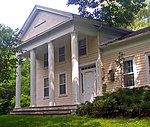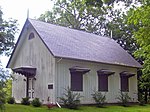Esopus Creek is a 65.4-mile-long (105.3 km) tributary of the Hudson River that drains the east-central Catskill Mountains in the U.S. state of New York. From its source at Winnisook Lake on the slopes of Slide Mountain, the Catskills' highest peak, it flows across Ulster County to the Hudson at Saugerties. Many tributaries extend its watershed into neighboring Greene County and a small portion of Delaware County. Midway along its length, it is impounded at Olive Bridge to create Ashokan Reservoir, the first of several built in the Catskills as part of New York City's water supply system. Its own flow is supplemented 13 miles (21 km) above the reservoir by the Shandaken Tunnel, which carries water from the city's Schoharie Reservoir into the creek.
The creek, originally known by the Native Americans in the area as Atkarkaton or Atkankarten and by Dutch settlers as the "Esopus Kill",: 56 takes its name from the Esopus tribe of the Lenape, who were living around the lower Esopus when the Dutch first explored and settled the Hudson Valley in the early 17th century. The creek's wide valley made it an ideal trading route for the Esopus and other Lenape who harvested the beaver pelts the European traders desired. Later, under the English, it became the beginning point for contentious land claims in the mountains. After independence, the Esopus corridor became the main route into the Catskills, first by road then later by the Ulster and Delaware Railroad, for forest-product industries like logging, tanning and charcoal making. Those industries declined in the late 19th century, shortly before the creation of the Forest Preserve and the Catskill Park made the region more attractive for resorts and recreation, particularly trout fishing. The renewed Esopus also attracted the attention of fast-growing New York City, which was able to acquire land and build the reservoir and tunnel after overcoming local political opposition.
The reservoir divides the creek into an upper stretch, mostly a wild mountain stream, and a lower stretch closer to the Hudson that gradually becomes more estuarine. Above the reservoir, its water quality is closely monitored, not only for its role in the city's water supply but to preserve its local economic importance as a recreational resource. As the upper Esopus is one of the most productive trout streams in the Northeast, fly fishermen come in great numbers to take trout from its relatively accessible banks. Canoeists and kayakers have been drawn to its whitewater, which has also spawned a busy local tubing industry in the summer months. The lower Esopus is mainly an aesthetic and ecological resource, although the estuary at Saugerties is a popular bass fishery.
The Esopus's role in the state and regional economy has led to a concentrated effort to protect and manage it, particularly on the upper stretch. The interests of the various stakeholders have not always converged, particularly where it concerns the city's management of its water needs. Turbidity created by discharges from the Shandaken Tunnel after a 1996 flood led to a successful lawsuit against the city and a state regulation; downstream of the reservoir the city has been criticized for contributing to flooding problems by releasing too much water during heavy rainstorms since Hurricane Irene in 2011. Boaters and anglers have also clashed, and invasive species are beginning to enter the upper creek as well.









